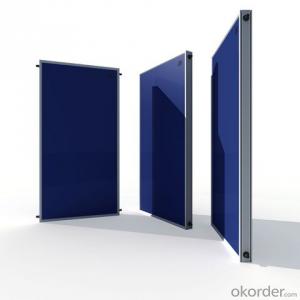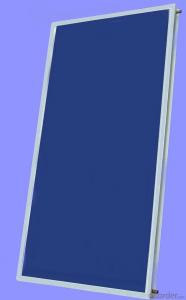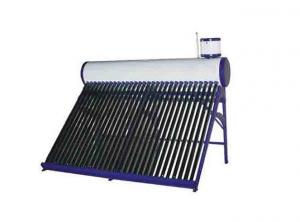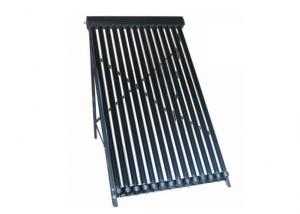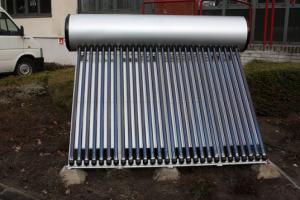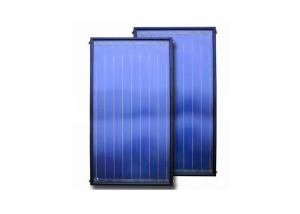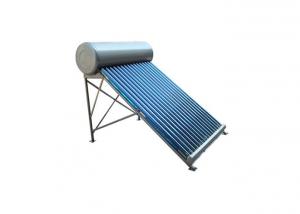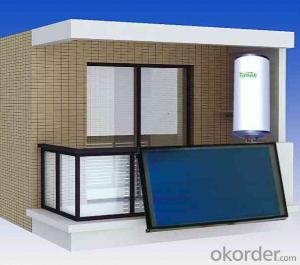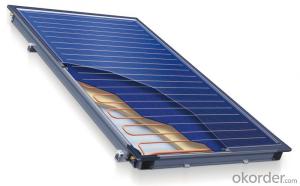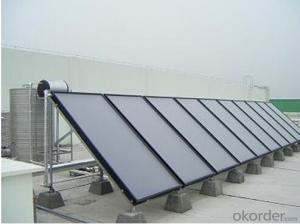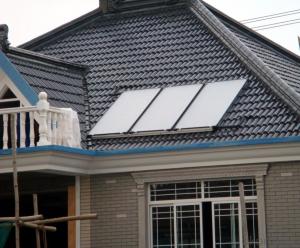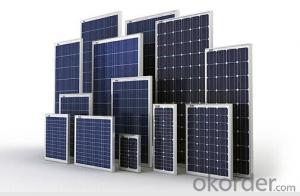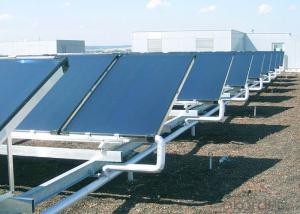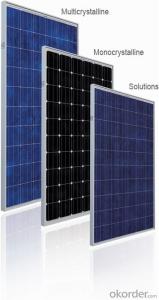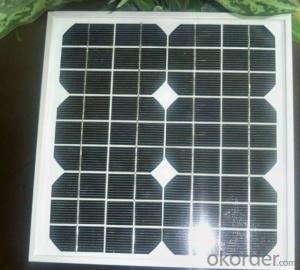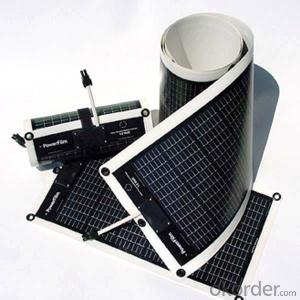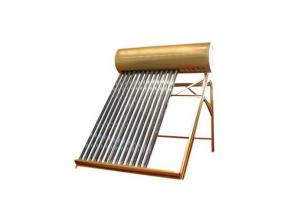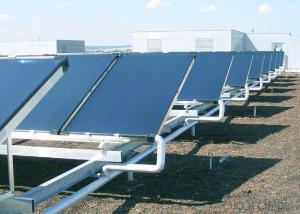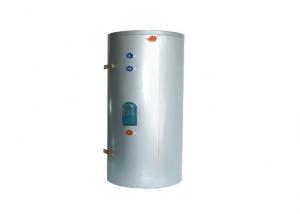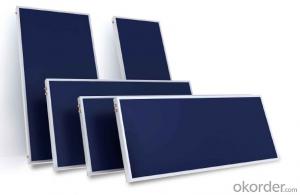Smallest CNBM Flat Plate Solar Thermal Collectors 2024
- Loading Port:
- Shanghai
- Payment Terms:
- TT OR LC
- Min Order Qty:
- 500 pc
- Supply Capability:
- 10000 pc/month
OKorder Service Pledge
OKorder Financial Service
You Might Also Like
High pressure, Good quality, OEM, ODM accepted.
production line improted from Germany.
1. Full-sheet absorber & Strip absorber collector
2. Ultrasonic welding
3. Absorber can be Cu-Cu & Cu-AL
4. All kinds of structure of flat collectors such as vertical collector, horizontal collector, ect.
5. Different coating including black chromed, blue sputtering, black anodized, ect.
Special design for oversea market.
Special Anodized aluminum alloy frame ensures handsome appearance and can bear high pressure without leakage.
50mm Fiberglass insulation and EPDM seal strip to assure the solar collector can work under harsh and very cold temperature.
Patterned tempered glass or low-iron tempered glass(4mm) is not easy broken with very high transmission and low emission.
Operation temperature -33℃~120℃.
Specifications
Flat Panel Solar Collector for Solar Water Heateing
1.Certificate:CE,ISO,CCC
2.Life time:25years
3.OEM provide
Description:
Flat-plate collector is one of common solar collectors for solar hot water heating in homes and solar space heatings. Flat plate solar collectors provide quality hot water with its new solar energy efficient flat plate design. This glazed collector includes a selective coating to maximize the solar heat absorption, weather resistant aluminium framing and interior fibreglass insulation for increased efficiency.
Features:
1. Using patent advanced coating technology with high efficiency performance
2. High strength aluminium-alloy structure with surface varnish baking
3. High visual shape, easy installation, maintenance free
4. Pressurized designing, operate with pressure up to 100degree
5. Can be combined with existing energy
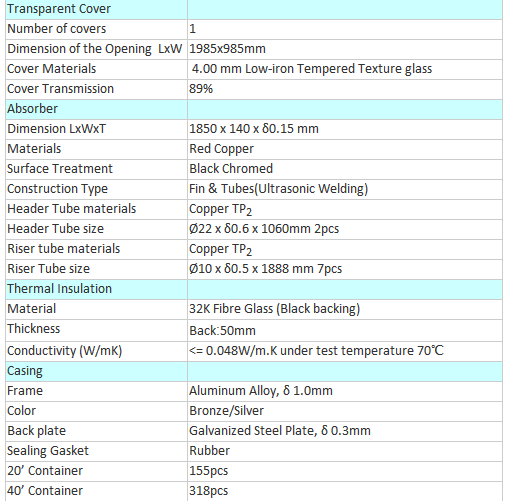
- Q: How do solar collectors affect air quality?
- Solar collectors have a positive impact on air quality as they generate electricity without emitting harmful pollutants or greenhouse gases. By reducing the reliance on fossil fuels for energy production, solar collectors help to mitigate air pollution and contribute to a cleaner and healthier environment.
- Q: Can solar collectors be used in cold climates?
- Yes, solar collectors can be used in cold climates. While the efficiency of solar collectors may be reduced in colder temperatures, they are still capable of generating heat and producing energy from sunlight. Additionally, advancements in technology have led to the development of solar panels that are designed to withstand and even perform well in extreme cold conditions.
- Q: Can solar collectors be used in solar thermal desalination?
- Yes, solar collectors can be used in solar thermal desalination. Solar thermal desalination is a process that utilizes solar energy to desalinate seawater or brackish water, converting it into fresh drinking water. Solar collectors, such as flat-plate collectors or parabolic troughs, are used to capture and concentrate the sun's energy, which is then used to heat the water and generate steam. This steam is further condensed to produce fresh water, while the remaining concentrated brine is disposed of. Solar collectors are an integral part of the solar thermal desalination process, as they provide the necessary heat energy to drive the desalination process without relying on fossil fuels or electricity. By harnessing the abundant and renewable solar energy, solar collectors make solar thermal desalination a sustainable and environmentally friendly solution for addressing water scarcity issues in arid regions.
- Q: Can solar collectors be used to generate electricity for electric vehicle charging stations?
- Solar collectors, like PV panels, have the capability to generate electricity for charging stations dedicated to electric vehicles. These collectors are specifically designed to directly convert sunlight into usable electricity. The electricity produced can then be utilized to power the charging stations, providing a clean and renewable energy source for charging electric vehicles. By harnessing solar energy, these charging stations can decrease their reliance on traditional fossil fuels and contribute to a transportation system that is more sustainable and environmentally friendly. Moreover, solar energy can be stored in batteries or fed back into the grid, guaranteeing a consistent and dependable power supply for the charging stations, even during periods of limited sunlight. In summary, integrating solar collectors into the infrastructure of electric vehicle charging is a practical and effective method to encourage the adoption of electric vehicles and reduce carbon emissions.
- Q: Can solar collectors be used in parking lots?
- Yes, solar collectors can be used in parking lots. They can be installed on canopies or mounted on poles to capture solar energy and convert it into electricity. This energy can then be used to power lighting systems, electric vehicle charging stations, and other electrical equipment in the parking lot, reducing the dependency on traditional power sources and promoting sustainability.
- Q: Can solar collectors be used in incineration plants?
- Yes, it is possible to utilize solar collectors in incineration plants. Solar collectors function as devices that convert solar energy into heat energy, which can then be utilized for various purposes. In the case of incineration plants, solar collectors can be employed to supply heat for the incineration process. Incineration plants are facilities that burn waste materials at high temperatures to generate energy. Typically, the heat produced from the combustion process is utilized to produce steam, which subsequently powers turbines to generate electricity. By utilizing solar collectors, the heat necessary for the incineration process can be supplemented or even replaced, thereby reducing reliance on fossil fuels and decreasing the carbon emissions associated with the plant's operation. To capture the sun's energy and convert it into heat, solar collectors can be integrated into the design of incineration plants. These collectors typically consist of a series of solar panels or tubes that absorb sunlight and transfer the heat to a working fluid, such as water or oil. This heated fluid can then be employed to provide the required heat for the incineration process. The utilization of solar collectors in incineration plants offers numerous advantages. Firstly, it diminishes reliance on fossil fuels, making the plant more sustainable and environmentally friendly. Secondly, it can help reduce operating costs by offsetting the need for conventional heat sources, such as natural gas or coal. Lastly, solar collectors can enhance the overall efficiency of the incineration process by providing a consistent and dependable source of heat. However, it is essential to note that the integration of solar collectors in incineration plants necessitates careful planning and engineering. Factors such as the plant's location, available sunlight, and the design of the solar collector system must be considered to ensure optimal performance. Additionally, the size and capacity of the solar collector system must be appropriately determined to meet the heat requirements of the incineration process. In conclusion, solar collectors can indeed be employed in incineration plants to supply heat for the incineration process. By harnessing the sun's energy, these collectors provide a sustainable and cost-effective solution to reduce reliance on fossil fuels and decrease carbon emissions in the operation of incineration plants.
- Q: Can solar collectors be used in waste-to-energy plants?
- Solar collectors are indeed capable of being utilized in waste-to-energy plants. These plants convert waste materials into usable energy, usually in the forms of heat or electricity. To supplement the energy production process, solar collectors, such as solar thermal collectors or photovoltaic panels, can be integrated into these plants. The utilization of solar thermal collectors involves capturing solar energy and transforming it into heat. This heat can then be employed in waste-to-energy plants to generate steam, which powers turbines for electricity production. By incorporating solar thermal collectors, waste-to-energy plants can decrease their reliance on fossil fuels, reduce greenhouse gas emissions, and enhance overall energy efficiency. Moreover, photovoltaic panels can also be implemented in waste-to-energy plants to directly convert sunlight into electricity. This electricity can be utilized to operate various functions within the plant or even be fed back into the power grid. By employing solar collectors, waste-to-energy plants can diversify their energy sources and further contribute to renewable energy objectives. Nevertheless, it is crucial to consider various factors such as available space, climate conditions, and cost considerations when integrating solar collectors into waste-to-energy plants. Depending on the specific circumstances, waste-to-energy plants may prioritize other renewable energy sources like wind or biomass. However, the use of solar collectors in waste-to-energy plants presents a practical option to enhance sustainability and minimize environmental impact in energy generation from waste.
- Q: Can solar collectors be used for heating churches?
- Yes, solar collectors can be used for heating churches. Solar thermal systems can harness the energy from the sun to generate heat, which can then be used to warm up the interior spaces of churches. By installing solar collectors on the roof or nearby areas, churches can significantly reduce their reliance on traditional heating methods and lower their energy costs while promoting sustainable practices.
- Q: What are the disadvantages of using solar collectors?
- Using solar collectors comes with a few drawbacks. To begin with, the initial expense of installing them can be quite high. The necessary equipment and materials, like photovoltaic panels or solar thermal collectors, can be costly, which might pose a financial barrier for some individuals or businesses who lack the necessary resources. Furthermore, solar collectors rely on sunlight to generate energy. Consequently, they are less efficient in areas with limited sunlight or on cloudy days. This intermittency can lead to fluctuations in energy production, necessitating the use of backup systems or storage solutions to ensure a consistent supply of electricity or hot water. Maintenance and upkeep of solar collectors can also be a disadvantage. Over time, the panels can collect dust, dirt, or other debris, diminishing their efficiency. Regular cleaning and maintenance are required to maintain optimal performance. Additionally, repairing or replacing any malfunctioning or broken components can be expensive and time-consuming. Lastly, the space needed for installing solar collectors can be a limiting factor. Solar panels or collectors typically require a substantial amount of unobstructed sunlight and may pose a challenge in urban or densely populated areas where space is limited. In conclusion, while solar collectors offer various benefits such as renewable energy generation and a reduced carbon footprint, it is crucial to consider these disadvantages before making an investment in this technology.
- Q: How long does it take to recoup the cost of installing solar collectors?
- The time it takes to recoup the cost of installing solar collectors can vary depending on several factors such as the initial cost of the installation, the amount of energy saved or generated, and the local energy prices. However, on average, it usually takes between 5 to 10 years to recoup the cost of installing solar collectors through energy savings.
Send your message to us
Smallest CNBM Flat Plate Solar Thermal Collectors 2024
- Loading Port:
- Shanghai
- Payment Terms:
- TT OR LC
- Min Order Qty:
- 500 pc
- Supply Capability:
- 10000 pc/month
OKorder Service Pledge
OKorder Financial Service
Similar products
Hot products
Hot Searches
Related keywords
